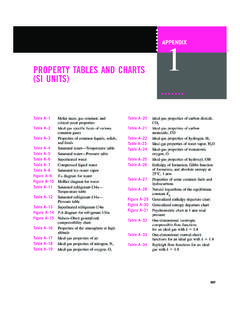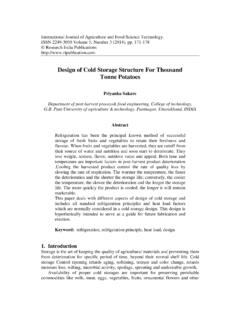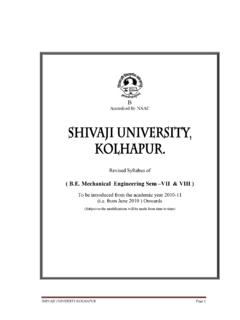Transcription of Psychrometrics, Level 1: Introduction - Sigler …
1 PsychrometricsLevel 1: IntroductionPSYCHROMETRICS Technical Development Programs (TDP) are modules of technical training on HVAC theory, system design, equipment selection and application topics. They are targeted at engineers and designers who wish to develop their knowledge in this field to effectively design, specify, sell or apply HVAC equipment in commercial applications. Although TDP topics have been developed as stand-alone modules, there are logical group-ings of topics. The modules within each group begin at an introductory Level and progress to advanced levels. The breadth of this offering allows for customization into a complete HVAC curriculum from a complete HVAC design course at an introductory- Level or to an advanced- Level design course. Advanced- Level modules assume prerequisite knowledge and do not review basic concepts. Psychrometrics is the study of the air and water vapor mixture.
2 Proficiency in the use of the psychrometric chart is an important tool for designers of air conditioning systems. Psychromet-rics is required to properly calculate heating and cooling loads, select equipment, and design air distribution systems. While the topic is not complicated, it involves a number of formulas and their application; the psychrometric chart is useful in simplifying the calculations. This module is the first of four on the topic of psychrometrics. This module introduces the air-vapor mixture and how the psychrometric chart can be used to determine the mixture s properties. This module also explains how to plot the eight basic air conditioning processes on the chart . Other modules build on the information from this module to explain the psychrometrics of various air conditioning systems, analysis of part load and control methods, computerized psychrometrics, and the theory used to develop the chart . 2005 Carrier Corporation. All rights reserved.
3 The information in this manual is offered as a general guide for the use of industry and consulting engineers in designing systems. Judgment is required for application of this information to specific installations and design applications. Carrier is not responsible for any uses made of this information and assumes no responsibility for the performance or desirability of any resulting system design. The information in this publication is subject to change without notice. No part of this publication may be reproduced or transmitted in any form or by any means, electronic or mechanical, for any purpose, without the express written permission of Carrier Corporation. Printed in Syracuse, NY CARRIER CORPORATION Carrier Parkway Syracuse, NY 13221, Table of Contents 1 What is Psychrometrics?.. 2 Properties of Air and Vapor .. 2 How Air and Water Vapor are Measured .. 3 Humidity and Its 4 How the Air-Vapor Mixture 4 Temperature and 5 Building the psychrometric 7 Dry Bulb Temperature Scale.
4 7 Specific Humidity Scale .. 7 Dew Point and the Saturation Line ..8 Relative Humidity Lines .. 9 Wet Bulb Temperature Specific Volume 12 Enthalpy Scale (Total Heat Content) .. 12 State Point .. 13 Using the psychrometric chart ..14 Examples Using State Points .. 15 Air Conditioning 17 Eight Basic Process Types .. 17 Sensible and Latent Heat 18 Sensible Heat Factor .. 20 Sensible Heat Factor 21 Sensible Heating and 22 Humidification and Dehumidification .. 23 Air Mixing .. 24 Finding Room 24 Evaporative Cooling .. 25 Cooling with Dehumidification .. 26 Cooling Coils and the Bypass Factor .. 27 Evaporative Cooling and Humidity Control .. 30 Heating and 32 Heating and Dehumidification ..32 Process chart .. 33 Summary .. 36 Work Session 1 .. 37 Work Session 2 .. 38 40 List of Symbols and 40 Thermodynamic Properties of Water At Saturation: 42 Thermodynamic Properties of Moist Air: Units .. 50 psychrometric chart , Normal Temperature, Sea Level .. 56 Work Session 1 Answers.
5 57 Work Session 2 Answers .. 60 Glossary .. 65 PSYCHROMETRICS, Level 1: Introduction Psychrometrics 1 Introduction Why does an air-conditioning design course begin with psychrometrics? In the computer-aided design world of today, is psychrometrics a necessary and practical topic to understand? The answer is that the principles of psychrometrics provide the key to understanding why the air con-ditioning industry exists and will help explain many of the processes and steps used in system design. It is so important, we have four TDP modules devoted to psychrometrics. This first mod-ule has four sections: properties of air and vapor, building the psychrometric chart , state points, and air conditioning processes. Other modules describe using psychrometrics to analyze proc-esses and determine loads or airflows, using psychrometrics to evaluate performance of compound systems with the psychrometric chart or computer tools, and psychrometric formula and the theory used to construct the chart .
6 Many of the terms and concepts are used in daily conversation, yet we may not recognize them as psychrometrics. What does relative humidity really mean? How does a cooling coil re-move water vapor? What causes air conditioning ducts to sweat? The answers to questions such as these depend upon the properties of air and water vapor and how they act together. Being able to analyze air conditioning systems with an understanding of these properties means better oper-ating systems and lower costs. The history of psychrometrics started on a foggy evening in 1902 on a train platform in Pitts-burgh. A young engineer for Buffalo Forge Company was working on an air conditioning design problem involving a Brooklyn printer who was having a problem with color registration between printing press runs. Color printing was done at that time by running the paper through the presses for each primary color. The concen-tration of the various color dots gave the pictures their color.
7 Since paper changes dimension-ally with changes in the humidity, on some days, the colors were not lining up, leading to poor quality and wasted materials. On this foggy night, the young engineer observed the fog condensing on cold surfaces and determined that there was a relationship between temperature and humidity. As temperature dropped, the air could hold less moisture. It fol-lowed that a temperature could be reached where the air could hold no more moisture and a concept called dew point control was born. This understanding of dew point allowed him to solve the printer s problem. The young engineer, Willis Carrier, went on to mathematically describe the phenomena he observed that night and the science of psychrometrics was born. Figure 1 Dr. Carrier and the Brooklyn Printing Plant PSYCHROMETRICS, Level 1: Introduction Psychrometrics 2 The formulas that were developed were plotted on a chart that is the psychrometric chart .
8 This chart is one of the most useful tools a system designer has to describe air conditioning proc-esses. What is Psychrometrics? Psychrometrics is the study of the thermo-dynamic properties of moist air. In other words, if the air is to be conditioned, how can the amount of heat that must be added or removed and the amount of moisture that must be added or removed be determined? This is what we can learn from our study of psychrometrics. Properties of Air and Vapor We will start at the beginning with air itself. Atmospheric air is a mixture of a number of gases. The two primary gases are nitrogen and oxygen. Nitrogen accounts for 77 percent of air s weight by volume and oxygen ac-counts 21 percent. The remaining 1 percent is trace amounts of other gases, but these do not appear in vol-umes significant enough to be a factor in psychrometric calculations. Five uses for psychrometrics: Determine the temperature at which condensation will occur in walls or on a duct.
9 Find all the properties of moist air by knowing any two conditions. Calculate the required airflow to the space and the equipment to satisfy the loads. Determine the sensible and total cooling load the unit needs to provide Determine the coil depth and temperature to meet the design load conditions. Figure 2 Composition of Dry Atmospheric Air PSYCHROMETRICS, Level 1: Introduction Psychrometrics 3 Atmospheric air has one other element in this mixture of gases commonly called air: water vapor. Water vapor is not present in large quantities in the atmosphere; how-ever, it is a significant factor to those concerned with the field of psy-chrometrics and air conditioning. How Air and Water Vapor are Measured Air conditioning is the simultaneous control of temperature, humidity, cleanliness, and distri-bution. So, the first order of business in order to control temperature and humidity, is how they can be measured.
10 Once temperature and humidity are determined, then the amount of each to be removed or added can be calculated. Convention for the industry is to base calculations of air properties on pounds. Since air is a mixture, and not a compound, the amount of moisture in the mixture can change. Therefore, to have a common measuring point, moisture content is defined by com-paring the moisture content at any point to dry air. The amount of actual water vapor present in a quantity of air is so small that it is measured in grains. It takes 7000 grains to make up one pound. Since one pound of air at 100 F, with all the water it can hold, contains grains (about ounce), this water does not have much bearing on the actual weight of the air. The actual final weight of a volume of air will be the sum of the air s dry weight and the weight of the water vapor it contains. The unit of measurement for moisture content is pounds of moisture per pound of dry air (lb / lbda).





